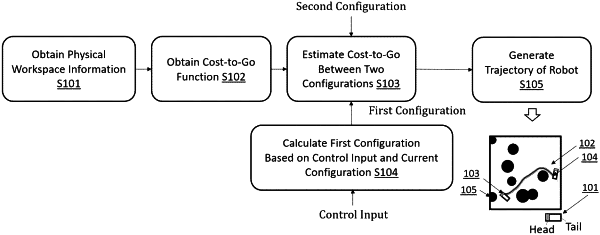| CPC G05D 1/0221 (2013.01) [G05D 1/0246 (2013.01); G06N 3/045 (2023.01); G06T 17/00 (2013.01); G06T 2207/10028 (2013.01)] | 18 Claims |

|
1. An electronic device for generating a trajectory of a target device from a current position to a goal position within an environment, the electronic device comprising:
a memory configured to store instructions; and
a processor configured to execute the instructions to:
obtain physical workspace information associated with the environment in which the target device is configured to operate with non-holonomic constraints;
input the physical workspace information to a first neural network to obtain a set of weights representing a cost-to-go function relating to a length of a collision-free path from one position to the goal position;
identify a next position of the target device based on the current position and a motion control input of the target device;
configure a second neural network based on the set of weights that are output from the first neural network, wherein the second neural network is trained to estimate the length of the collision-free path based on a training dataset that is selected through an adaptive sampling method of increasing a sampling probability based on a cost-to-go gradient of the length of the collision-free path; and
input the identified next position of the target device and the goal position to the second neural network to identify the trajectory to the goal position, and the motion control input corresponding to the trajectory,
wherein the electronic device or the target device corresponds to an autonomous driving device;
wherein the adaptive sampling method is configured to generate the training dataset based on a ratio of each of the cost-to-go gradients to a corresponding Euclidean distance gradient; and
wherein the processor is configured to generate the trajectory of the target device from a next position to the goal position based on the cost-to-go gradient so that an estimated cost is minimized, and to control the autonomous driving device to travel according to the trajectory based on the motion control input.
|